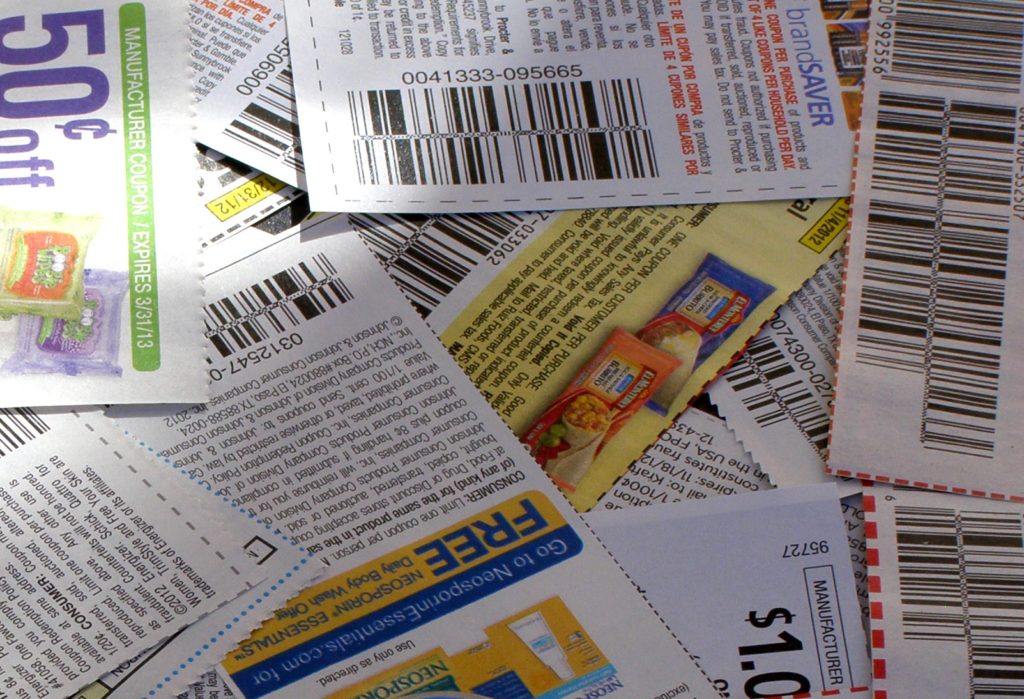
It’s been quite a year. As you peruse the annual recaps of calamities and celebrity obituaries, you might be tempted to bid 2016 good riddance already. But before you do, why not take a few moments to see what made an impact in the world of couponing this past year?
It’s time for Coupons in the News to bring you its fifth annual look at the top stories of the year. Many of these stories were reported first – or only – on Coupons in the News. So if you’re a regular reader, you’re already more knowledgeable than most. If you missed a few stories, though, now’s your chance to catch up on the events that had the greatest impact on the world of couponing in 2016:
10. The slow decline of doubles
Kroger’s decision to do away with double coupons in eight separate regions back in 2013 is still having ripple effects today. The controversial move by the country’s largest traditional grocery store has emboldened competitors to do the same.
In 2016, it was Publix’s turn to end the practice of doubling coupons in the majority of its stores that still offered the promotion. Tellingly, the last remaining region where Publix still doubles, is the last remaining region where Kroger still doubles. So the only question now, is which of the coupon-doubling competitors will blink first.
Meanwhile, Kroger itself had some unfinished business to attend to in its Denver division. Just a few months before Publix’s move, Kroger-owned King Soopers announced the end of double coupons in its stores, calling it “an effort to modernize the company’s coupon policies.”
When it comes to couponer-friendly perks, unfortunately, it seems “modern” isn’t always better.
9. The hologram is dead. Long live the hologram!
When coupon counterfeiters began faking the silver hologram that designated a genuine free-product coupon, what was the coupon industry to do? How about designing a new hologram – and making it gold?
That worked for about a minute.
Free-product coupons that companies mail to consumers in response to a comment or complaint are among the most sought-after by counterfeiters, who reproduce them and sell them online. In an effort to thwart them, member companies of the Coupon Information Corporation began using a new difficult-to-replicate gold hologram strip across the top of their coupons.
And coupon scammers promptly began counterfeiting the gold hologram.
The silver hologram was in use for four years before it was retired in favor of the gold hologram, which lasted all of a few months before it was compromised.
To coupon counterfeiters, fake free-product coupons are free money – and despite the industry’s best intentions, this situation showed that the fraudsters aren’t about to give up without a fight.
8. Coupon stats reveal a troubling trend
Does it seem like you’re using fewer coupons these days than you used to? Join the club.
New figures released this year showed that the coupon redemption rate dipped to a 40-year low – a rather alarming nadir for the popular promotional tool.
That could, or should, have led to some industry soul-searching – are consumers losing interest in coupons, or are they just not interested in the types of coupons they’re being offered?
The rate of decline seemed to slow midway through the year, as manufacturers offered more and better coupons for food – the very types of coupons that shoppers say they prefer.
Could it be that simply offering better coupons will result in a better coupon redemption rate? Year-end redemption figures will be out within the next month – so we’ll soon find out.
7. The changing world of rebate apps
Snap by Groupon went away. Shopmium went awry. And several startups want in on the game.
Shoppers who’ve embraced cash-back apps had plenty of changes to keep up with this year.
First, Snap by Groupon announced an “exciting” transition that turned out to be the virtual demise of the app itself. Then, Shopmium alienated couponers by announcing it would ban the practice of combining coupons and rebates, and subsequently prevented the app from being used by millions of shoppers in dozens of stores that Shopmium decided didn’t adequately itemize their receipts.
But it wasn’t all bad news for receipt-scanning fans. Market leaders Ibotta and Checkout 51 added new capabilities, while startups like bevRAGE, Adjoy and Snapstar joined the party.
While you’ve been busy clipping coupons all these years – who could have guessed that your receipts would end up being arguably even more valuable?
6. The changing world of Coupons.com
Coupons.com is synonymous with printable coupons. So when the site makes a change, couponers notice. And when it makes two significant changes in a year – couponers really notice.
First, Coupons.com weighed in on the controversial practice of hunting for coupons by zip code – by putting a stop to the practice altogether. The site now localizes coupons based on your IP address, so you can no longer go on fishing expeditions for regional coupons by typing in different zip codes and seeing what pops up.
The next big change, still underway, is the phaseout of Coupons.com’s downloadable printing software. The printable provider is transitioning to its new PrintID process, which prompts you to authenticate your device with a phone number before you’re able to print.
That means, instead of two unique coupon prints per device that you own, you’ll be limited to two unique coupon prints per phone number that you have.
Most couponers have reluctantly gotten used to the zip code changes by now. As we enter the new year, the print process changes may continue to be a more challenging adjustment.
5. Target targets coupon scammers
It’s not so easy to misuse coupons at Target anymore.
Target made subtle changes to its coupon policy, and major changes to its point-of-sale cash register software this summer. The goal was to better match coupons to specific products, and prevent cashiers from being able to override error messages, to help ensure that coupons are no longer used on items for which they’re not intended.
That dealt a serious blow to coupon glitching, or “glittering”, or “balanced couponing”, or whatever practitioners of the coupon-abusing craft are calling it now. The changes meant the abusers can’t get away with it so much at Target anymore.
And as other retailers update their own registers, the glitchers may find that their days are numbered.
4. Ad match no more
For years, if you found a lower price in a competitor’s ad for something sold at Walmart, Walmart would match it right at the register.
Not anymore, at hundreds of stores across the country.
Walmart phased out its Ad Match program in at least 800 stores this year. Officially, the rationale was that those Walmart stores already had the lowest prices around. Unofficially, the rationale appeared to be aimed at eliminating fraudulent ad match requests that had Walmart honoring impossibly low prices.
So once again, it seems, fraudsters forced a policy change that affects everyone. And this is why we can’t have nice things.
3. Major coupon fraud conviction
Coupon fraudsters aren’t always consumers. Sometimes they’re millionaire former CEOs of coupon processing companies.
Nearly a decade after his indictment, Chris Balsiger was found guilty of running a coupon fraud scheme that prosecutors said cost major manufacturers some $250 million. Balsiger, the former CEO of coupon processing company International Outsourcing Services, was found to have falsely submitted coupons for reimbursement that were never used by shoppers. Prosecutors said Balsiger hired crews to cut out coupons, mixed them in with coupons that were legitimately redeemed in stores, and pocketed the extra cash.
His ten former co-defendants all reached deals with prosecutors and avoided trial. Balsiger chose to defend himself – and now he’ll pay the price. He’s due to be sentenced in March.
2. Fighting the coupon fairies
Printable coupons generally have a two-print limit. But some people have discovered ways to get thousands – and they’ve turned their coupon-printing prowess into a business.
That left the printable coupon providers with a major new problem on their hands this year. The sellers, who dubbed themselves “coupon fairies”, weren’t counterfeiting coupons. They weren’t photocopying them. They were getting a virtually unlimited number of unique, legitimate prints by “tricking” the printable sites into thinking their print requests were coming from thousands of individual computers.
As the most prominent printable provider, Coupons.com was the most affected. It scrambled to stop the coupon fairies by closing the loopholes they were exploiting.
The outcome of that case, against an Ohio woman, is still pending. If closing loopholes doesn’t stop the fairies – maybe legal threats will.
1. Thwarting the insert thieves
Many large-scale “coupon clipping services” and insert sellers have dropped the pretense that they’re buying extra newspapers in order to get extra coupons to sell.
Instead, many are obtaining inserts by the pallet, from people along the distribution chain who have very likely stolen them from newspaper warehouses before they ever had a chance to be delivered to their intended recipients.
So never mind the academic arguments about the legalities and ethics of buying and selling coupons. It’s now increasingly becoming a cut-and-dry case of trafficking in stolen property – and it’s becoming one of the biggest challenges the coupon industry is facing.
At least three people were arrested this year, charged with illegally obtaining and/or selling coupons. One was a former employee of a newspaper distribution facility. Another was a police officer, who allegedly spent his off-duty hours breaking and entering and stealing coupon inserts from a warehouse for his insert-selling wife, who was also arrested.
In the meantime, the coupon industry is pursuing a separate line of attack, by trying to cut off the coupon sellers’ supplies. Procter & Gamble declined to deliver its brandSAVER to a California distributor last month, and many insert sellers suddenly had no P&G coupons for their customers – confirming the company’s suspicions about where the insert sellers’ coupons were coming from.
Insert publishers have never liked it when people sold their coupons online. But as long as the sellers kept it small-scale, they were largely left alone. No so with the large-scale sellers. If they end up getting shut down in the new year, it may be their own greed that does them in.
* * * * * * * * * *
So there you have it – the top Coupons in the News stories of 2016. And they’re just a small sampling of the hundreds of stories that have appeared here throughout the year. So if you haven’t already, please consider bookmarking the site, becoming a Facebook fan, following @couponinthenews on Twitter or subscribing to the daily email newsletter to ensure that you’re always plugged in to the latest news. And feel free to get in touch by emailing couponsinthenews@gmail.com with comments, questions or news tips any time!
Thank you for your support throughout the year, and stay tuned for plenty more coupon news in 2017!
Photo by ccPixs.com















